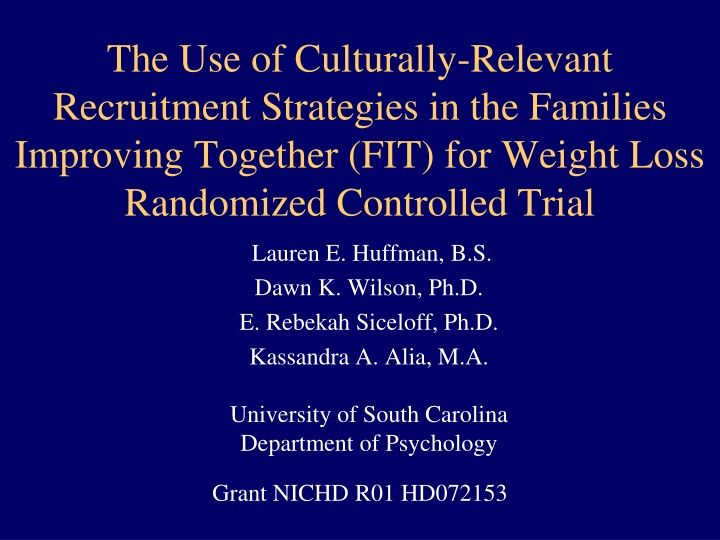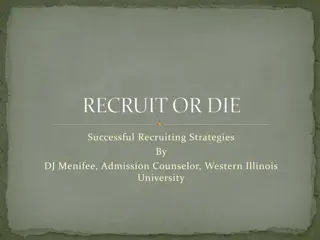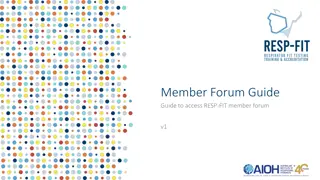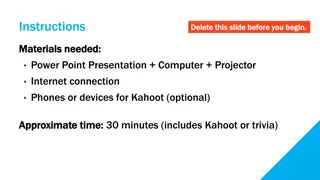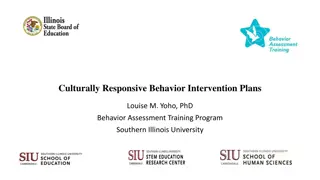Culturally Relevant Recruitment Strategies in Project FIT
Culturally relevant recruitment strategies are essential in engaging African American families in weight loss interventions. The Families Improving Together (FIT) trial utilizes a motivational approach targeting parent communication, autonomy support, problem-solving, and youth monitoring. The study design includes face-to-face group meetings and an online program with specific calorie goals to promote gradual weight loss. Overcoming barriers such as competing demands and unclear benefits through culturally tailored recruitment strategies can enhance participation in health promotion trials like Project FIT.
Download Presentation

Please find below an Image/Link to download the presentation.
The content on the website is provided AS IS for your information and personal use only. It may not be sold, licensed, or shared on other websites without obtaining consent from the author.If you encounter any issues during the download, it is possible that the publisher has removed the file from their server.
You are allowed to download the files provided on this website for personal or commercial use, subject to the condition that they are used lawfully. All files are the property of their respective owners.
The content on the website is provided AS IS for your information and personal use only. It may not be sold, licensed, or shared on other websites without obtaining consent from the author.
E N D
Presentation Transcript
The Use of Culturally-Relevant Recruitment Strategies in the Families Improving Together (FIT) for Weight Loss Randomized Controlled Trial Lauren E. Huffman, B.S. Dawn K. Wilson, Ph.D. E. Rebekah Siceloff, Ph.D. Kassandra A. Alia, M.A. University of South Carolina Department of Psychology Grant NICHD R01 HD072153
Obesity in the United States: Adolescents and Adults Figure 1. Overweight and Obesity by Adult Age Overweight and Obesity by Child Age 20 75 Child Age 2-5 yrs 6-11 yrs 12-17 yrs 16 65 Percent Percent 12 55 8 45 Adult Age 18-29 yrs 30-44 yrs 45-64 yrs 65-74 yrs 4 35 25 0 1971-74 1976-80 1988-94 1999-00 2001-03 2003-04 2005-06 1971-74 1976-80 1988-94 1999-00 2001-03 2003-04 2005-06 CDC/NHIS, 2008
Project FIT Parenting and motivational approach for weight loss in African American families Target parent communication, autonomy-support , problem solving, monitoring of youth 16-week Intervention 8 weekly face-to-face group meetings 8 week online program Specific calorie goals 200 300 calorie reduction in energy intake 100 200 calorie energy expenditure Promote gradual weight loss
FIT Study Design Randomization #1 Randomization #2 Run-In Period (Group Face-to- Face Sessions) (Online Program) Online Intervention Intervention Group Online Control 2 Week Orientation Online Intervention Control Group Online Control
Barriers to Participation in Health Promotion Trials Competing demands (time, financial, priorities) Perceived benefit of participating in research programs may not be clear Lack of cultural perspective Resnicow, Braithwaite, Ahluwalia, & Dilorio (2001)
Culturally-Relevant Recruitment Strategies Surface-Level Strategies Peripheral Evidential Constituent-involving Deep Structure/Sociocultural Strategies Kreuter, Lukwago, Bucholtz, Clark, & Sanders-Thompson (2003) Resnicow, Baranowski, Ahluwalia, & Braithwaite (1999)
Applying these Recruitment Strategies to Project FIT Surface-Level Strategies Flyers and brochures Local events and festivals that cater to a broad population Deep Structure Strategies Healthcare partnerships Church partnerships Sociocultural events Culturally-relevant ads
Methods: Coding Surface-Level Strategies General community events School referrals Word of mouth Other (included calls from flyers) Deep Structure Strategies Community partnerships Culturally-relevant ads Sociocultural community events
Study Sample Characteristics Characteristics of Adolescent Sample Sex Female (%) 95 (69.3) Male (%) 42 (30.7) Age Mean (SD) 13.7 (1.7) BMI Mean (SD) 32.0 (6.0)
Annual Family Income 30 25 Percentage of Families 20 15 10 5 0 < 10k 10-24k 25-39k Annual Income 40-54k 55-69k 70-84k >85k
Percentage of Participants Based on Recruitment Strategy 40% 35% 30% 25% 20% 15% 10% 5% 0%
Comparison of Demographic and Psychosocial Variables Across Groups Child-Level Variables by Retention Status Lost to Run-in Retained Count (%) Female Male Total 41 (77.4) 12 (22.6) 53 (38.7) 54 (64.3) 30 (35.7) 84 (61.3) Mean (SD) BMI Age* Self Efficacy for PA Self Efficacy for Diet 33.4 (7.7) 14.0 (1.7) 3.4 (0.7) 3.2 (0.8) 31.2 (6.2) 13.4 (1.7) 3.5 (0.7) 3.2 (0.9) Note. Baseline data for self-efficacy variables available for a portion of the total sample (n=88); PA=physical activity. *p = 0.05
Comparison of Demographic and Psychosocial Variables Across Groups Family-Level Variables by Retention Status Lost to Run-in Retained Yearly Family Income < $10,000 12.5% 13.1% $10,000-24,000 37.5% 22.6% $25,000-39,000 12.5% 26.2% $40,000-54,000 0.0% 10.7% 37.5% 27.4% $55,000 Parent Education 9 to 11 Years 0.0% 3.6% 12 Years 25.0% 14.5% Some College 37.5% 37.3% 4 Year College 12.5% 21.7% Professional Degree 25.0% 22.9% Note. Baseline data for income and education variables available for a portion of the total sample (n=88).
Summary Using culturally-appropriate strategies can address potential barriers to including minority populations in health research. Community partnerships and culturally relevant ads are effective recruitment strategies for reaching this population. Adolescent age may be a factor of influence in retention of families
Acknowledgements Principal Investigator Dawn K. Wilson, Ph.D. Co-Investigators Ken Resnicow, Ph.D. Heather Kitzman-Ulrich, Ph.D. M. Lee Van Horn, Ph.D. Ron Prinz, Ph.D. Sara St. George, M.A. Staff and Graduate Assistants - Kassandra Alia, M.A. - Madison Hilliard - Franklin Jones - Carlyn Joseph - Tyler McDaniel, M.A. - Kaya Outen - E. Rebekah Siceloff, Ph.D.
